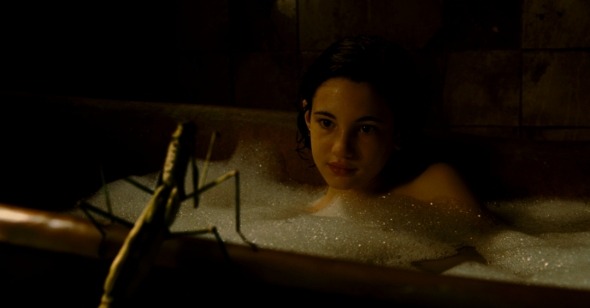Lost in the Maze
by Andrew Tracy
Pan’s Labyrinth
Dir. Guillermo del Toro, Mexico, Picturehouse
It’s curious to see what habits foreign directors who have toiled in Hollywood can bring back home with them. Paul Verhoeven’s latest, the shamelessly entertaining Black Book, his first film in the Netherlands in over 20 years, retains numerous Hollywood banalities—glaring close-ups, omnipresent music, and ridiculously telegraphed plot points—yet caught up as they are in Verhoeven’s exultantly vulgar, sub-Rabelaisian aesthetic, they’re almost negligible. Where Verhoeven returns to his native language to get away with even more outrageousness than he could in the U.S., Guillermo del Toro, with his execrable new effects-fest Pan’s Labyrinth, returns to his in order to give a gloss of Art to those same banalities of style and sentiment which Verhoeven effortlessly subsumes. Unlike such fellow hacks as Wolfgang Petersen and Roland Emmerich, whose pecuniary instincts have made them American directors regardless of their nationality, del Toro is often regarded as bringing a dose of exoticism and a “personal” touch to standard-issue Hollywood blockbusters, though to these eyes he hasn’t proven much beyond his ability to choose good production designers. Where del Toro is unusually canny, however, is in using this orientalist view of his work to make a lateral move into the art-house market.
While certain informed quarters attempt to elevate select entertainments to the level of art, the far more powerful trend these days is to lower art to the level of entertainment—by simply viewing the employment of a language other than English as marker of a film’s heightened ambition. This is by no means a uniform process—Park Chan-wook’s static, glossy nastiness has won him the mantle of art-house auteur while the far more artful Bong Joon-ho is still regarded as a genre director—but when filmmakers like del Toro know how to tap into it, they can use audience laziness to give new respectability to their tired tropes. So Pan’s Labyrinth gets a free ride on a foreign tongue, while its fairy tale premise allows critics to talk of archetypes and tradition rather than clichés and formula. Who wants to be the killjoy to rail against such fantastical prerequisites as plucky children, dangerous quests, magical beings, evil stepfathers, and the Spanish Civil War (qué?).
Yep, as with his 2001 film The Devil’s Backbone, del Toro uses the war as a glib backdrop to give weight to his already leaden flights of imagination, and its use here is even more insultingly superficial. Not to mention exploitative: the setting allows del Toro to indulge in bouts of show-off sadism in the person of the monotonously brutal Captain Vidal (Sergi Lopez), aforementioned adoptive padre of our heroine Ofelia (the admittedly adorable Ivana Baquero). In this enchanting little fable, then, Vidal administers an Irreversible-style face-crushing to an unlucky peasant, blows a number of CGI-aided holes through hearts and heads, and even destroys the film’s sole authentic gesture—a mortally wounded partisan fruitlessly pushing away the revolver about to deliver his coup de grace—with a shamefully calculated bit of gore: why merely shoot a man in the head when you can blow off his hand as well?
Even in its most grotesque manifestations, however, this inexplicable violence is always tempered by the grey-tinged aura of “seriousness” hanging over the film—this is Art, remember, so Verhoeven’s bright, Technicolored blood geysers just won’t do. Regrettably, these wholly unrealistic exercises in tony bloodshed are actually the film’s most imaginative aspect in light of its painful literal-mindedness in the realm of the fantastic. There’s some promise of clever obliqueness in the opening minutes when Ofelia encounters a huge dragonfly and dubs it a “fairy”—but del Toro shows his hand almost immediately by actually having the thing turn into a goddamn fairy. From that moment on, Ofelia’s quest to save her pregnant mother from her brutal new husband and regain her own rightful place as the immortal “princess of the underground kingdom” (or something; it’s in the prologue if you care) progresses through an increasingly mechanical hodgepodge of fairy tale swipes: magic stones, magic keys, magic roots, et cetera and ad nauseam.
No one’s going to argue with the elaborateness of this fantasy bric-a-brac (God bless production designers), but elaborate is a poor substitute for imaginative—except for those cheerleader critics who are laboring to make them synonymous. It’s precisely because del Toro’s film has none of the texture, mystery, and surprise of actual imagination that it’s garnered the plaudits it has. Imagination, please, but within limits—and that means national and linguistic limits as well. Garin Nugroho’s exquisite Opera Jawa, a marvelously creative expansion of the traditional gamelan opera form, creates more magic with a roll of red silk than all of Pan’s CGI beasties combined, but after all, who could be expected to go see a Javanese film? So Nugroho’s lovely and surprising work of imagination can be swept into the ethnographic dustbin while del Toro’s EuroHollywood perfume piece gets whisked into the echelons of Art on those “archetypical” inanities of good and evil, mother-love. and childhood innocence.
It’s almost unfair to compare this dreck to The Spirit of the Beehive (1973), but consider what VĂctor Erice’s masterpiece suggests within both the same historical setting and the same child-eyed narrative: that evil might be far less visible than one might think; that maternal love can share space with an even more powerful, sexual love in which children play no part; that childhood innocence itself can contain selfishness, ignorance, and shocking cruelty. Erice’s fairy tale deepens our lived world; del Toro’s merely pilfers the shallow detritus of pop fantasies and comforting banalities. “Innocence has a power evil cannot imagine,” blare the ads for Pan—though judging from the outcome of the war, which del Toro conveniently forgets, it would seem that evil’s lack of imagination puts up no obstacles to its hold on the only power that matters. And as Erice shows us, innocence and evil may have far more correspondences than we would like to think.
